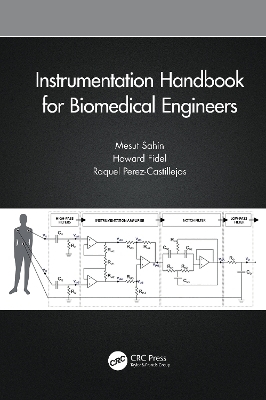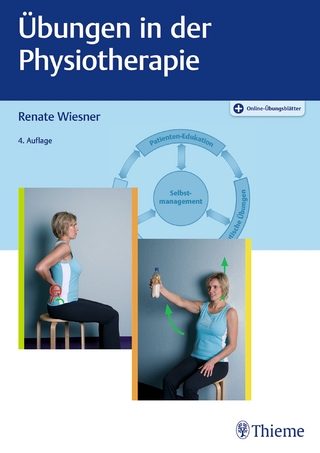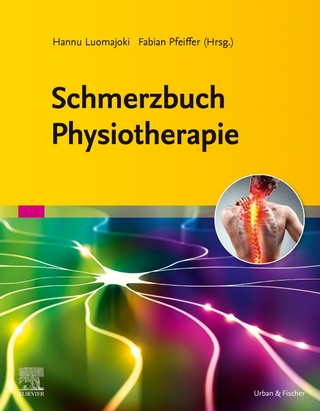
Instrumentation Handbook for Biomedical Engineers
Crc Press Inc (Verlag)
978-1-4665-0466-0 (ISBN)
Key Features:
• Hands-on laboratory exercises on measurements of biophysical and biomedical variables
• Each laboratory exercise is complete by itself and they can be covered in any sequence desired by the instructor during the semester
• Electronic equipment and supplies required are typical for biomedical engineering departments
• Data collected by undergraduate students and data analysis results are provided as samples
• Additional information and references are included for preparing a report or further reading at the end of each chapter
Students using this book are expected to have basic knowledge of electrical circuits and troubleshooting. Practical information on circuit components, basic laboratory equipment, and circuit troubleshooting is also provided in the first chapter of the book.
Mesut Sahin earned his B.S. degree in electrical engineering from Istanbul Technical University in 1986. After graduation, he worked for a telecommunication company, Teletas A.S., in Istanbul in hardware and software development of phone exchanges until 1990. He earned the M.S. degree in 1993 and a Ph.D. degree in 1998, both in biomedical engineering, particularly in the field of neural engineering, from Case Western Reserve University, Cleveland, Ohio. After post-doctoral training at the same institute, he joined Louisiana Tech University as an Assistant Professor in 2001. He has been on the faculty of Biomedical Engineering at New Jersey Institute of Technology, Newark, New Jersey since 2005, and currently is a Full Professor, where he teaches bioinstrumentation and neural engineering courses. His research interests are mainly in neural modulation and development of novel neural prosthetic approaches. He has authored more than 90 peer-reviewed publications. Dr Sahin is an Associate Editor of IEEE Transactions on Biomedical Circuits and Systems and a Senior Member of IEEE/EMBS. Howard Fidel served as Vice President of Technology for IREX/ Johnson and Johnson Ultrasound, where he developed the market leading Meridian Cardiology system. After leaving Johnson and Johnson in 1986, he founded Universal Sonics Corporation, as a contract engineering company and a manufacturer of OEM Medical Devices supporting the Ultrasound and Medical Device industry. Universal Sonics’ customer base included many well-known clients, including ATL, Acuson, Biosound, and many others. After the acquisition of Universal Sonics by US Surgical, Mr. Fidel left to become Chief Operating Officer of Stern Ultrasound, a startup company that was in the process of developing a mid-market ultrasound system. Later he functioned as C.T.O. and C.O.O of 3G Ultrasound. In 2017, Mr. Fidel became an adjunct Professor at the New Jersey Institute of Technology teaching biomedical engineering. Mr. Fidel earned a BE degree with High Honors from Stevens Institute of Technology in 1972, an MS in Bioengineering from the University of Connecticut in 1974, and an MBA with Distinction from Pace University in 1984. He holds eight patents in the ultrasound field. In 2016, he was inducted into the New Jersey Inventors Hall of Fame. He currently lives in Tarrytown, NY and grew up in Brooklyn, NY. He is married to Professor Marlene Brandt Fidel, and has a daughter, Rivka Fidel, Ph.D. Raquel Perez-Castillejos earned her B.S. degree in telecommunications engineering with a specialization in Microelectronics from the Polytechnic University of Catalonia in 1996. She earned her Ph.D. from the Institute of Microelectronics of Barcelona in 2003, followed by a post-doctoral stay in 2003–2004 at the University of Sao Paulo and postdoctoral training at Harvard University, Department of Chemistry and Chemical Biology, from 2004 to 2008. She joined the faculty of the New Jersey Institute of Technology from 2008 to 2016 and is currently an Independent Consultant in Biomedical Devices specialized in applications of microelectronics and microfluidics for cell biology and biochemical analyses. Dr. Raquel Perez-Castillejos has authored and co-authored 29 peer-reviewed papers, 5 patents, and more than 50 conference proceedings abstracts.
Contents
Foreword, xi
Preface, xiii
About the Authors, xv
Abbreviations, xvii
Introduction, xix
Studio 1 ◾ Body Thermometer Using a Wheatstone Bridge
and the Projection Method 1
S1.1 LEARNING OBJECTIVES 1
S1.2 BACKGROUND 1
S1.3 OVERVIEW OF THE EXPERIMENT 3
S1.4 SAFETY NOTES 3
S1.5 EQUIPMENT, TOOLS, ELECTRONIC
COMPONENTS AND SOFTWARE 3
S1.6 PRE-LAB QUESTIONS 4
S1.7 DETAILED EXPERIMENTAL PROCEDURE 5
S1.7.1 Circuit Testing and Troubleshooting 6
S1.8 DATA ANALYSIS AND REPORTING 9
S1.9 POST-LAB QUESTIONS 9
REFERENCES AND MATERIAL FOR FURTHER READING 9
Studio 2 ◾ Electrophysiological Amplifier: Recording
Electrocardiograms Through A Breadboard 11
S2.1 LEARNING OBJECTIVES 11
S2.2 BACKGROUND 12
S2.3 OVERVIEW OF THE EXPERIMENT 23
S2.4 SAFETY NOTES 24
S2.5 EQUIPMENT, TOOLS, ELECTRONIC
COMPONENTS AND SOFTWARE 24
S2.6 PRE-LAB QUESTIONS 25
S2.7 DETAILED EXPERIMENTAL PROCEDURE 26
S2.8 DATA ANALYSIS AND REPORTING 34
S2.9 POST-LAB QUESTIONS 35
S2.10 ADDITIONAL EXPERIMENTAL ACTIVITIES 36
REFERENCES AND MATERIALS FOR FURTHER READING 37
Studio 3 ◾ Small Signal Rectifier-Averager for EMG Signals 39
S3.1 BACKGROUND 39
S3.2 OVERVIEW OF THE EXPERIMENT 40
S3.3 LEARNING OBJECTIVES 40
S3.4 SAFETY NOTES 40
S3.5 EQUIPMENT, TOOLS, ELECTRONIC
COMPONENTS AND SOFTWARE 40
S3.6 CIRCUIT OPERATION 41
S3.7 DETAILED EXPERIMENTAL PROCEDURE 43
S3.8 CIRCUIT TESTING AND TROUBLESHOOTING 47
S3.9 QUESTIONS FOR BRAINSTORMING 47
S3.10 IMPORTANT TOPICS TO INCLUDE IN THE LAB
REPORT 48
REFERENCES AND MATERIALS FOR FURTHER READING 48
Studio 4 ◾ Digital Voltmeter: Usage of Analog-to-Digital
Converters 49
S4.1 BACKGROUND 49
S4.2 OVERVIEW OF THE EXPERIMENT 50
S4.3 LEARNING OBJECTIVES 50
S4.4 NOTES ON SAFETY 51
S4.5 LIST OF MATERIALS 51
S4.6 CIRCUIT OPERATION 52
S4.7 DETAILED EXPERIMENTAL PROCEDURE 55
S4.8 CIRCUIT TESTING AND TROUBLESHOOTING 58
S4.9 QUESTIONS FOR BRAINSTORMING 60
S4.10 IMPORTANT TOPICS TO INCLUDE IN THE
LAB REPORT 61
REFERENCES AND MATERIAL FOR FURTHER READING 61
Studio 5 ◾ Force Measurements with PZT Transducers 63
S5.1 BACKGROUND 63
S5.2 OVERVIEW OF THE EXPERIMENT 63
S5.3 LEARNING OBJECTIVES 63
S5.4 EQUIPMENT, TOOLS, ELECTRONIC
COMPONENTS AND SOFTWARE 64
S5.5 DETAILED EXPERIMENTAL PROCEDURE 65
S5.6 CIRCUIT TESTING AND TROUBLESHOOTING 71
S5.7 DATA ANALYSIS AND REPORTING 71
REFERENCES AND MATERIALS FOR FURTHER READING 72
Studio 6 ◾ Oscillometric Method for Measurement of
Blood Pressure 73
S6.1 BACKGROUND 73
S6.2 OVERVIEW OF THE EXPERIMENT 74
S6.3 LEARNING OBJECTIVES 74
S6.4 NOTES ON SAFETY 74
S6.5 EQUIPMENT, TOOLS, ELECTRONIC
COMPONENTS AND SOFTWARE 74
S6.6 CIRCUIT OPERATION 76
S6.7 DETAILED EXPERIMENTAL PROCEDURE 76
S6.8 CIRCUIT TESTING AND TROUBLESHOOTING 84
S6.9 IMPORTANT TOPICS TO INCLUDE IN THE LAB
REPORT 85
REFERENCES AND MATERIAL FOR FURTHER READING 85
Studio 7 ◾ Electronic Stethoscope: Heart Sounds 87
S7.1 BACKGROUND 87
S7.2 OVERVIEW OF THE EXPERIMENT 88
S7.3 LEARNING OBJECTIVES 88
S7.4 SAFETY NOTES 88
S7.5 EQUIPMENT, TOOLS, ELECTRONIC
COMPONENTS, AND SOFTWARE 88
S7.6 DETAILED EXPERIMENTAL PROCEDURE 89
S7.7 CIRCUIT TESTING AND TROUBLESHOOTING 92
S7.8 DATA ANALYSIS AND REPORTING 93
REFERENCES AND MATERIALS FOR FURTHER READING 93
Studio 8 ◾ Transmission Photoplethysmograph: Fingertip
Optical Heart Rate Monitor 95
S8.1 BACKGROUND 95
S8.2 OVERVIEW OF THE EXPERIMENT 100
S8.3 LEARNING OBJECTIVES 101
S8.4 SAFETY NOTES 101
S8.5 EQUIPMENT, TOOLS, ELECTRONIC
COMPONENTS AND SOFTWARE 101
S8.6 DETAILED EXPERIMENTAL PROCEDURE 102
S8.7 DATA ANALYSIS AND REPORTING 106
S8.8 PRE-LAB QUESTIONS 107
S8.9 POST-LAB QUESTIONS 108
REFERENCES AND MATERIALS FOR FURTHER READING 108
Studio 9 ◾ Measurement of Hand Tremor Forces with
Strain-Gauge Force Transducer 111
S9.1 BACKGROUND 111
S9.2 OVERVIEW OF THE EXPERIMENT 112
S9.3 LEARNING OBJECTIVES 112
S9.4 SAFETY NOTES 112
S9.5 EQUIPMENT, TOOLS, ELECTRONIC
COMPONENTS AND SOFTWARE 112
S9.6 DETAILED EXPERIMENTAL PROCEDURE 114
S9.7 CIRCUIT TESTING AND TROUBLESHOOTING 120
S9.8 DATA ANALYSIS AND REPORTING 121
REFERENCES AND MATERIALS FOR FURTHER READING 122
Studio 10 ◾ Optical Isolation of Physiological Amplifiers 123
S10.1 BACKGROUND 123
S10.2 OVERVIEW OF THE EXPERIMENT 123
S10.3 LEARNING OBJECTIVES 124
S10.4 SAFETY NOTES 124
S10.5 EQUIPMENT, TOOLS, ELECTRONIC
COMPONENTS AND SOFTWARE 124
S10.6 CIRCUIT OPERATION 125
S10.7 DETAILED EXPERIMENTAL PROCEDURE 127
S10.8 CIRCUIT TESTING AND TROUBLESHOOTING 130
S10.9 QUESTIONS FOR BRAINSTORMING 132
S10.10 IMPORTANT TOPICS TO INCLUDE IN LAB REPORT 132
REFERENCES AND MATERIALS FOR FURTHER READING 132
Studio 11 ◾ Extraction of Respiratory Rate from ECG
(ECG-Derived Respiration-EDR) 133
S11.1 BACKGROUND 133
S11.2 OVERVIEW OF THE EXPERIMENT 133
S11.3 LEARNING OBJECTIVES 134
S11.4 SAFETY NOTES 134
S11.5 EQUIPMENT, TOOLS, ELECTRONIC
COMPONENTS AND SOFTWARE 134
S11.6 DETAILED EXPERIMENTAL PROCEDURE 134
S11.7 DATA ANALYSIS AND REPORTING 135
REFERENCES AND MATERIALS FOR FURTHER READING 139
Studio 12 ◾ Heart Rate Variability Analysis in Frequency
Domain 141
S12.1 BACKGROUND 141
S12.2 OVERVIEW OF THE EXPERIMENT 143
S12.3 LEARNING OBJECTIVE 143
S12.4 SAFETY NOTES 143
S12.5 EQUIPMENT AND SOFTWARE 144
S12.6 DETAILED EXPERIMENTAL PROCEDURE 144
S12.7 DATA ANALYSIS 145
REFERENCES AND MATERIALS FOR FURTHER READING 152
Studio 13 ◾ AC Impedance of Electrode-Body Interface 153
S13.1 BACKGROUND 153
S13.2 OVERVIEW OF THE EXPERIMENT 154
S13.3 LEARNING OBJECTIVES 154
S13.4 SAFETY NOTES 154
S13.5 EQUIPMENT, TOOLS, ELECTRONIC
COMPONENTS AND SOFTWARE 155
S13.6 CIRCUIT OPERATION 156
S13.7 DETAILED EXPERIMENTAL PROCEDURE 156
S13.8 CIRCUIT TESTING AND TROUBLESHOOTING 159
S13.9 QUESTIONS FOR BRAINSTORMING 159
S13.10 IMPORTANT TOPICS TO INCLUDE IN LAB REPORT 159
REFERENCES AND MATERIALS FOR FURTHER READING 160
APPENDIX I: USING ELECTRONIC COMPONENTS AND
CIRCUIT DESIGN, 161
APPENDIX II: REQUIRED EQUIPMENT AND MATERIALS, 175
INDEX, 181
| Erscheinungsdatum | 28.10.2020 |
|---|---|
| Zusatzinfo | 9 Tables, black and white; 8 Line drawings, color; 57 Line drawings, black and white; 24 Halftones, black and white; 9 Illustrations, color; 73 Illustrations, black and white |
| Verlagsort | Bosa Roca |
| Sprache | englisch |
| Maße | 156 x 234 mm |
| Gewicht | 566 g |
| Themenwelt | Medizin / Pharmazie ► Physiotherapie / Ergotherapie ► Orthopädie |
| Technik ► Elektrotechnik / Energietechnik | |
| Technik ► Maschinenbau | |
| Technik ► Medizintechnik | |
| Technik ► Umwelttechnik / Biotechnologie | |
| ISBN-10 | 1-4665-0466-8 / 1466504668 |
| ISBN-13 | 978-1-4665-0466-0 / 9781466504660 |
| Zustand | Neuware |
| Informationen gemäß Produktsicherheitsverordnung (GPSR) | |
| Haben Sie eine Frage zum Produkt? |
aus dem Bereich


